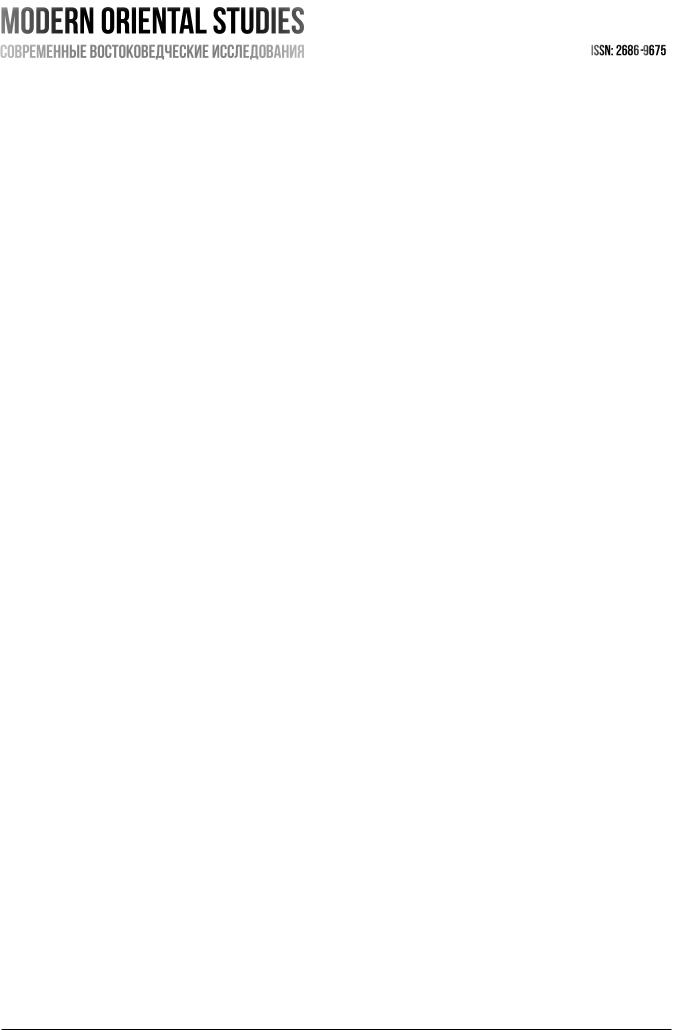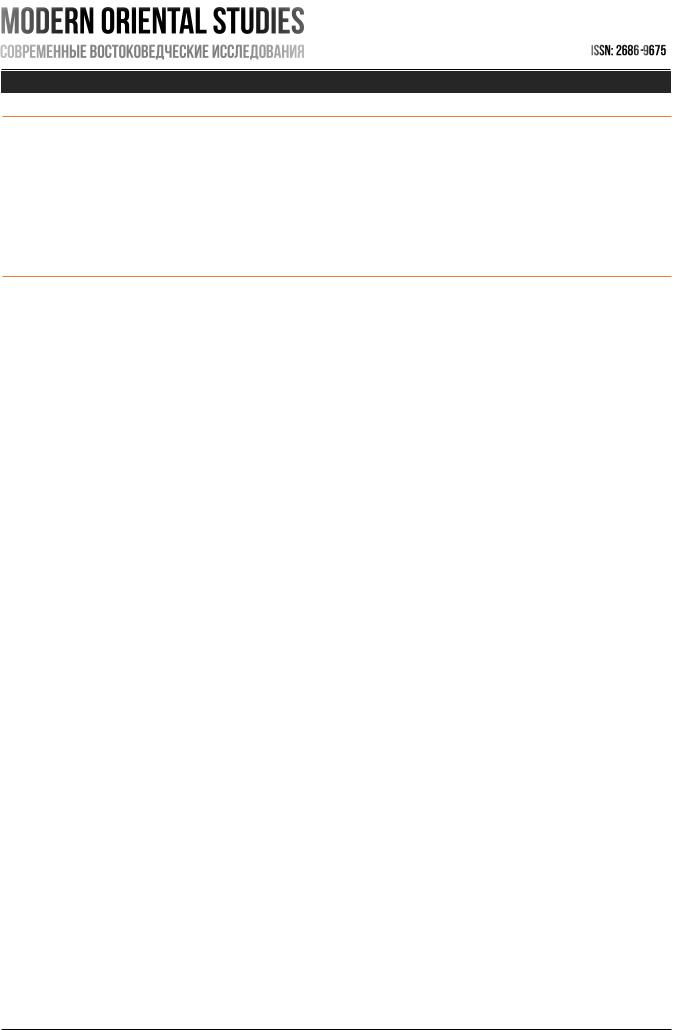
3-2020
.pdf
|
|
|
|
|
|
|
|
|
|
|
|
|
VOL.2 №3 2020 |
||
|
|
|
|
|
|
|
|
|
|
|
|
|
|||
|
|
|
|
|
|
|
|
|
|
|
|
|
|||
INTERNATIONAL SCIENCE JOURNAL / МЕЖДУНАРОДНЫЙ НАУЧНЫЙ ЖУРНАЛ |
|
|
|
|
|
|
|
|
|
|
|
|
|||
сексуальную фантазию. Ее |
мысли «Новои |
жен-вообще ничего не есть. |
Могу жить без еды. |
|
|||||||||||
щины» воспринимается не как акт выражения |
Лишь бы солнце светило» [1, 156]. Вместо того, |
||||||||||||||
ее собственных чувств, но как чтото привлека- |
чтобы преодолевать рамки, выстроенные для |
||||||||||||||
тельное для него самого, потому что он видит |
женщин в обществе, Е нхе предпочитает сбе- |
||||||||||||||
|
|
- |
|
|
жать от них. Она отказывается от сущности, |
||||||||||
ее идеи чемто, извраще нным и запретным, |
|||||||||||||||
и лишь поэтому – притягательным. |
|
|
которая принадлежала мужу, отцу, всем, но не |
||||||||||||
- |
|
|
|
|
ее и вопреки всем нормам и устоям, но самосто- |
||||||||||
Сначала повествования ясно, что решение |
|||||||||||||||
Е нхе отказаться от общественнои |
нормы по- |
ятельно, начинает думать о себе как о дереве. |
|||||||||||||
требления мяса также становится метафорои |
|
|
|
Путешествие Е нхе к самопознанию закан- |
|||||||||||
ее отказа от гендерных ролеи , связанных с ожи- |
чивается неоднозначно, и читателю остается |
||||||||||||||
даниями общества от женского тела: «Она вы- |
лишь предполагать, что она умерла. Последнии |
||||||||||||||
сыхала с каждым дне м. И без того выступаю- |
абзац романа иллюстрирует это, описывая деи - |
||||||||||||||
щие скулы некрасиво заострились. Без макия- |
ствия глазами ее сестры: «Тихо, очень тихо раз- |
||||||||||||||
жа кожа выглядела бле клои , как у больного |
дае тся ее |
вздох. Она вглядывается в стоящие |
|||||||||||||
[1, 28]». Для Е нхе вегетарианство —это попыт- |
деревья, в тот огромныи |
зеленыи |
волнующии |
||||||||||||
ка вернуть контроль над собственным телом |
косте р, |
ярко пылающии |
по обе стороны дороги, |
||||||||||||
с однои стороны, и над собственнои |
личностью |
и еи |
кажется, |
что эти деревья, как звери, вы- |
|||||||||||
с другои , но она терпит неудачу раз за разом, |
прямившие свои тела, тянутся вверх. Она смо- |
||||||||||||||
потому что личность ее , |
женщины кореи ского |
рит |
мрачно и настои чиво, |
словно жде т ответа. |
|||||||||||
общества, создае тся под давлением внешних |
Нет, |
|
словно |
протестует |
против |
чего то» |
|||||||||
сил. Эта конструкция лучше всего представлена |
[1, 187]. Инхе, кажется, протестует против мира, |
||||||||||||||
в сцене, когда ее муж говорит за нее на ужине |
которыи |
|
|
|
|
|
- |
|
|||||||
уничтожил ее сестру с его правилами |
|||||||||||||||
в компании, объясняя коллегам «приемлемую» |
соответствия. Сравнение деревьев с животны- |
||||||||||||||
причину ее вегетарианства [1, 43]. В этом случае |
ми намекает на то, что Е нхе в конце концов до- |
||||||||||||||
он лишает Е нхе ее собственного взгляда и ее |
стиг тои |
точки слияния с природои . Возрожде- |
|||||||||||||
борьбы, создавая новую, более правильную для |
ние Е нхе должно произои ти в форме смерти |
||||||||||||||
общества в целом концепцию. Это постоянное |
ее |
земного тела и слияния ее духа с природои , |
|||||||||||||
вторжение в путь самопознания Е нхе заставляет |
как она и задумывала. Для нее путь становле- |
||||||||||||||
ее сконцентрироваться на своеи |
физическои форния- |
|
|
«Новои |
Женщинои» |
должен закончиться |
|||||||||
ме, чтобы наи ти контроль и свободу деи ствииее |
полнои |
властью над своим телом, даже если |
|||||||||||||
над созданием своеи собственнои личности. |
Жен- |
это означает его разрушение. |
|
|
|||||||||||
Для Е нхе воплощение образа «Новои |
ЗАКЛЮЧЕНИЕ |
|
|
|
|
||||||||||
щины» приходит к кульминации в третии части |
|
|
|
Изучение персонажа Е нхе показывает, что |
|||||||||||
романа, когда она начинает полностью отказы- |
ценои |
подрыва социальных норм, |
особенно |
||||||||||||
ваться от своеи человеческои |
формы и сходит |
связанных с полом, становится полное уничто- |
|||||||||||||
с ума: «Я уже не животное, сестра. Я теперь могу |
жение самого себя. Независимость Е нхе подвер- |
||||||||||||||
40

«НОВАЯ ЖЕНЩИНА» В СОВРЕМЕННОМ КОРЕЙСКОМ РОМАНЕ |
VOL.2 №3 2020 |
|
|||||||
«ВЕГЕТАРИАНКА» ХАН ГАН |
|
|
|
|
|
|
|
||
|
|
|
|||||||
|
|
|
|||||||
Философия и культура / АЛИКБЕРОВА А.Р., КАМИНА Д.С. / KAMINSE@YANDEX.RU / УДК 1751 |
|
|
|||||||
галась нападкам со стороны старых устоев, пат- |
|
BIBLIOGRAPHIC REFERENCES |
|
||||||
риархата, выраженных в лице персонажеи , |
1. |
Han K. Vegetarian / Lee S. U. – M.: Isdatelstvo |
|
||||||
окружающих ее , и чтобы обрести власть над |
|
||||||||
собои еи |
пришлось и вовсе перестать быть че- |
2. |
AST, 2017. – 190 p. |
|
|||||
ловеком. Через ее персонажа проиллюстриро- |
|
Kamina D.S. Ismenenie polojenia jenshin na |
|
||||||
ван тяжкии |
путь, прои денныи |
«Новои |
Женщи- |
primere rabot Kim Iryuop “Probujdenie” i Yn |
|
||||
ны», чтобы утвердиться в патриархальном об- |
|
Khigon “Duet”: kyrsivaya / D.S. Kamina. – |
|
||||||
ществе. И даже спустя несколько десятилетии |
|
Kazan, 2019. – 32 p. |
|
||||||
путь современнои кореи скои |
женщины к лич- |
|
- |
|
|||||
нои |
свободе, возможно, стал еще более слож- |
3. |
Kim Y. “Questioning Minds: Short Stories by |
|
|||||
|
Modern Korean Women Writers” / Ed. Yung |
|
|||||||
ным; «Новые Женщины» и сегодня испытыва- |
|
|
Hee, Kim. Honolulu: University of Hawai'i |
|
|||||
ют насилие общества, которое является менее |
|
4. |
Press, 2010. – 341 p. |
|
|||||
явным, но столь же разрушительным, как то, |
|
Kwon I. “The New Women’s Movement in |
|
||||||
которое она испытала сто лет назад. |
|
|
|
1920’s Korea: Rethinking the Relationship |
|
||||
ЛИТЕРАТУРА |
|
|
|
|
Between Imperialism and Women”. Gender & |
|
|||
1. Хан Г. Вегетарианка / Ли С.Ю. – М.: Изда- |
|
|
History. Vol.10, No.3, 1998. – 405 p. |
|
|||||
|
INFORMATION ABOUT AUTHORS |
|
|||||||
2. |
тельство АСТ, 2017. – 190 с. |
|
|
|
|
|
|
|
|
Камина Д.С. Изменение положения жен- |
п |
Alfiya Alikber |
va |
|
|||||
|
щин |
на примере работ |
Ким |
Ире |
sociate professor, , Ph.D in Historical Sciences, as- |
|
|||
|
«Пробуждение» и Ын Хиге н «Дуэт»: авто- |
aria Kamina |
, student, |
|
|||||
|
реф. Курсовая / Д.С. Камина. – Казань, |
|
|
|
|||||
|
Department of Altaic Studies and Sinology, |
|
|||||||
3. |
2019. – 32 с. |
|
- |
|
Kazan (Volga region) Federal University |
|
|||
Kim Y. “Questioning Minds: Short Stories by |
|
kaminse@yandex.ru |
|
||||||
|
Modern Korean Women Writers” / Ed. Yung |
|
|
||||||
|
Hee, Kim. Honolulu: University of Hawai'i |
|
Принята к публикации: 30.03.2020 |
|
|||||
4. |
Press, 2010. – 341 p. |
|
|
|
Submission Date: 30.03.2020 |
|
|||
Kwon I. “The New Women’s Movement in |
|
|
|
|
|||||
1920’s Korea: Rethinking the Relationship Between Imperialism and Women”. Gender & History. Vol.10, No.3, 1998. – 405 p.
41

VOL.2 №3 2020
INTERNATIONAL SCIENCE JOURNAL / МЕЖДУНАРОДНЫЙ НАУЧНЫЙ ЖУРНАЛ
NARRATIVE ASPECTS OF THE PAST-BIRTH ( ) IN BUDDHIST
STORIES OF KOREA AND SRI LANKA
НАРРАТИВНЫЕ АСПЕКТЫ ПРОШЛОЙ ЖИЗНИ ( ) В БУДДИЙСКИХ ИСТОРИЯХ РЕСПУБЛИКИ КОРЕЯ И ШРИ-ЛАНКИ
Kim Jin-Ryang, Ph.D. in Korean Language and Literature, assistant professor, Department of International Affairs, Qatar University
j.kim@qu.edu.qa
Kim Youngsuk, teaching assistant, Department of Altaic Studies and Sinology, Kazan (Volga region) Federal University
yskim1872@hanmail.net
АННОТАЦИЯ
Данное вводное исследование буддийских историй в Республике Корее и Шри-Ланке. Оно
нацелено на сравнительный анализ корейской буддийской истории, выбранной из средневекового исторического текста с историей Шри-Ланки из
важного сингальского литературного канона. Для этой цели будет проведен предварительный обзор обеих исходных книг, в котором основное внимание будет уделено характеристикам текстов и способу составления историй. Ожидаемые результаты этого исследования суммированы ниже: (1) введение в учебники для исследователей из Кореи и Шри-Ланки; (2) вводный анализ и сравнение буддийских историй о Корее и Шри-Ланке для
дальнейших исследований; (3) сравнительная оценка роли сверхъестественного в ранней буддийской повествовательной литературе обеих стран.
Ключевые слова и фразы: Самгукюса,
Мавамса, Шри-Ланка, буддийские истории, про-
шлая жизнь, естественность, Джатака.
Для цитирования: Ким Джин Рян, Ким Енсук. Нарративные аспекты прошлой жизни ( ) в буддийских историях Республики Корея и Шри-Ланки. Современные востоковедческие ис-
следования. 2020; 2(3): 42-49
ABSTRACT
This is an introductive study on Buddhist stories of both Korea and Sri Lanka. It aims a comparative analysis of a Korean Buddhist story selected from a medieval historic text with a Sri Lankan story from an important Sinhala literary canon. For this purpose, a preliminary survey to the both source books is going to be made focusing on characteristics of texts and the manner of composing stories. Expected outcomes through this study are summarized in three below: (1) an introduction to the source books for the researchers of both Korea and Sri Lanka; (2) an introductive analysis and comparison of Buddhist stories of both Korea and Sri Lanka for succeeding further researches; (3) a comparative appreciation of the role of the supernaturality in the earlier Buddhist narrative literature of both countries.
This work was supported by Seed Program for Korean Studies through the Ministry of Education of Republic of Korea and Korean Studies Promotion Service of the Academy of Korean Studies (AKS-2015- INC-2230011).
Keywords and phrases: Samgukyusa, Mavamsa, Sri Lanka, Buddhist stories, past-birth, the naturality, Jataka.
For citation: Kim Jin-Ryang, Kim Youngsuk. Narrative aspects of the past-birth ( ) in Buddhist stories of Korea and Sri Lanka. Modern oriental studies. 2020; 2(3): 42-49
42

НАРРАТИВНЫЕ АСПЕКТЫ ПРОШЛОЙ ЖИЗНИ ( ) В БУДДИЙСКИХ ИСТОРИЯХ |
|
VOL.2 №3 2020 |
|
|||||||||||
РЕСПУБЛИКИ КОРЕЯ И ШРИ-ЛАНКИ |
|
|
|
|
|
|
|
|
|
|
|
|
|
|
|
|
|
|
|
|
|
||||||||
|
|
|
|
|
|
|
||||||||
Философия и культура / KIM JIN-RYANG, KIM YOUNGSUK / J.KIM@QU.EDU.QA, YSKIM1872@HANMAIL.NET/ УДК 291.23 |
|
|
|
|
|
|
||||||||
1. |
INTRODUCTION |
|
part for understanding the role of the supernatu- |
|
||||||||||
|
This is an introductive study on Buddhist |
ralism as a narrative element in Buddhist stories. |
|
|||||||||||
|
All of discussions are generalized as a conclusion |
|
||||||||||||
stories of both Korea and Sri Lanka. It aims a com- |
in the chapter four. |
|
|
|
|
|
|
|
||||||
parative analysis of a Korean Buddhist story select- |
2. HISTORY RECORD UNDER THE BUDDHIST |
|
|
|||||||||||
ed from a medieval historic text with a Sri Lankan |
VIEW OF THE WORLD |
|
|
|
|
|
|
|||||||
story from an important Sinhala literary canon. For |
|
|
|
|
|
|
|
|
|
|
|
|
||
this |
purpose, a preliminary survey to the |
both |
|
|
|
|
|
|
|
|
|
|
|
|
source books is going to be made focusing on char- |
|
|
|
|
|
|
|
|
|
|
||||
|
|
The Samgukyusa (Overlooked Historical Rec- |
|
|||||||||||
acteristics of texts and the manner of composing |
ords of the |
Three |
Korean |
Kingdoms. |
|
) |
|
|||||||
stories. Expected outcomes through this study are |
|
|
|
|
|
|
|
|
|
|
|
|||
is a historical records of the three ancient Korean |
|
|||||||||||||
summarized in three below: (1) an introduction to |
|
|
|
|
|
|
|
|
|
|
||||
kingdoms: Shilla ( |
. 57BC~935AD), Goguryeo |
|
||||||||||||
the source books for the researchers of both Korea |
( |
|
. |
|
37BC~668AD) |
and |
Baekje ( |
|
. |
|
||||
and Sri Lanka; (2) an introductive analysis and |
18BC~660AD) with several other ancient tribes |
|
||||||||||||
comparison of Buddhist stories of both Korea and |
forming the origin of the history of Korean nation. |
|
||||||||||||
Sri Lanka for succeeding further researches; (3) |
However, it is not a literally history book because it |
|
||||||||||||
a comparative appreciation of the role of the super- |
includes not only historical facts but also many dif- |
|
||||||||||||
naturality in the earlier Buddhist narrative litera- |
ferent types of records like myths, legends, anec- |
|
||||||||||||
ture of both countries. |
|
dotes, and other marvelous things. The publication |
|
|||||||||||
|
- |
|
of this book is presumed somewhere between |
|
||||||||||
|
Stories about Buddhist monks and episodes |
1281 and 1283 in the king Chungyeol period of the |
|
|||||||||||
containing the ‘past birth’ in the Samgukyusa ( |
|
|
|
|
|
|
|
|
|
|
|
|
|
|
) and a Sri Lankan history book Maha vam saGoryeo Kingdom. |
|
|
|
|
|
|
|
|||||||
are the objects of this research. An old Sri Lankan |
Its author, a Buddhist monk named Iryeon |
|
||||||||||||
Buddhist story collection Saddharmaratna valiya |
( |
|
), intentionally include a great deal of mytho- |
|
||||||||||
is also a supplementary source book. In the next |
logical and folklorist materials. So that this book |
|
||||||||||||
chapter of this paper, there will be a brief survey |
usually has been compared with an official history |
|
||||||||||||
on the place of both source books in each country. |
book of the same three Korean kingdoms' era, ti- |
|
||||||||||||
In the chapter three, a comparative analysis of the |
|
|
|
|
|
|
|
- |
|
|
||||
tled Samguksagi (The History of the Three Korean |
|
|||||||||||||
- |
- |
|
|
|
|
|
|
), written by Kim Bu Sik ( |
|
|
||||
stories is going to be progressed focusing on the |
Kingdoms. |
|
|
|
|
|||||||||
past birth motif. The past birth motive is an aspect |
|
), a high government official of the Goryeo King- |
|
|||||||||||
of the supernaturality in Buddhist storytelling. It is |
dom, following the Chinese convention of Confu- |
|
||||||||||||
important not because of its strangeness but be- |
cian |
historiography. Finally, |
the Samgukyusa |
|
||||||||||
|
- |
|
is usually said as a treasure of Koreanology ranged |
|
||||||||||
cause of its role to propel the story. However, the |
|
|||||||||||||
role of this past birth motif in Buddhist stories |
from history, to literature, religions, geography, |
|
||||||||||||
seems different in both countries. This difference is |
archeology, architecture and the arts. |
|
|
|
|
|||||||||
assumed caused by the different intention of each |
|
|
The Samgukyusa examined how Buddhism |
|
||||||||||
author (or translator) who selected and composed |
has had a great influence on Korean culture since |
|
||||||||||||
the stories in their book. The chapter four argues |
the three Korean kingdoms period. Mahayana Bud- |
|
||||||||||||
the plot structure of stories. Plot is also a useful |
dhism first penetrated Goguryeo Kingdom through |
|
||||||||||||
43

VOL.2 №3 2020
INTERNATIONAL SCIENCE JOURNAL / МЕЖДУНАРОДНЫЙ НАУЧНЫЙ ЖУРНАЛ |
|
|
|
|
|
strong- |
China in 372 AD, and Baekje Kingdom adapted |
Lanka, and story of King Dut |
t haga |
man ī |
are |
||
Buddhism in 384 AD. A Goguryeo monk introduced |
ly believed as their history by the people of Sri |
|||||
Buddhism Shilla Kingdom somewhere between |
Lanka. In other side, this book is regarded as a his- |
|||||
417~458 in the king Nulji period, but in 527 Bud- |
tory of Buddhism reported by Maha |
viha ra of Anu- |
||||
dhism was officially allowed in Shilla through |
radhapura. The book is a record admiring the |
|||||
a martyrdom of a government official Yi Cha Don. |
kings’ charity for the Buddhist monastery during |
|||||
The Maha vam sa is a Sri Lankan chronicleAnuradhapura period. |
In |
this |
sense, |
the |
||
- |
Maha vam sa is either a history or a Buddhist canon. |
|||||
that had been converted by many authors since 6th |
||||||
century. It describes the royal descendants of Sri |
The Saddharmaratna |
valiya, preserved origi- |
||||
Lanka in chronological order. Especially the first |
nally in the form of palm leaf manuscripts in 13th |
|||||
part, presumed written by a Buddhist monk |
century as a translation of the 5th century Pali |
|||||
Maha na ma in sixth century, of this book has a simiwork the Dhammapadatthakata or Dhammapada |
||||||
lar writing pattern with Samgukuysa in the sense |
Commentary by a monk Dharmasena Thera, con- |
|||||
of a mixture of written records on Sri Lankan histo- |
tains many Buddhist stories including life stories |
|||||
ry and oral traditions. It also includes myths, leg- |
of many monks. Those stories are certainly a ver- |
|||||
ends, and folk tales of the island country. Further- |
sion of Ja taka tales concerning the previous births |
|||||
more, this book shows anecdotes of Buddhist |
of Gautama Buddha in both human and animal |
|||||
monks, stories on establishment of a temple, and |
form. Even they were originated from the Buddhist |
|||||
stories on images and pagodas as if we can find |
literature tradition, the Saddharmaratna valiya, |
|||||
such stories in the Samgukyusa. |
contains additional stories, expanded descriptions, |
|||||
Some stories in the Maha vam sa includingnew metaphors, and elaborate images not in the |
||||||
Buddha’s three times of visiting Sri Lanka, story |
Pali Dhammapada Commentary [4]. |
|
|
|
||
of King Vijaya the founding father of Sri Lanka, sto- |
The basic common feature of these three |
|||||
ry of Mahinda who introduced Buddhism to Sri |
main source books is that they are written or trans- |
|||||
Table 1. Jewels of the Doctrine: Stories of the Saddharma Ratnavalihya
Author |
Iryeon |
Maha na ma |
DharmasenaThera |
|
|
|
Samgukyusa |
āvaṃsa |
Saddh rmaratnāvaliya |
||
|
|
|
|
|
|
|
(a Buddhist monk) |
(a Buddhist monk) |
(a Buddhist monk) |
|
|
Publication |
1281~1283 |
6th century |
13th century |
|
|
|
(translated in Sinhala) |
|
|||
|
Oral tradition: myths, |
Oral tradition: myths, |
A Sinhala commentarial work on the |
||
Source Stories |
legends, folktales… |
Dhammapada / |
|
(before 5th centu- |
|
|
legends, folk tales, folk |
Written records: sto- |
ry) |
|
|
|
songs… |
ry of the Sinhala |
The Pali translation work entitled |
||
|
Written records: history, |
Dhammapadatthakatha (5th century) |
|||
|
biography… |
Kingdom of the is- |
The Sinhala re translation work entitled |
||
|
|
land |
Saddharmaratnavaliya (13th century) |
||
Buddhist Sto- |
Biography and anec- |
|
- |
|
|
|
|
|
|
||
ries Types |
dotes of monks; stories |
Anecdotes of monks; |
Illustrating stories on the doctrine |
||
|
of temples, images, and |
stories of temples, |
of the Dhammapada like as Jataka tales |
||
|
pagodas |
images, and pagodas |
|
|
|
|
|
|
|
|
|
44

НАРРАТИВНЫЕ АСПЕКТЫ ПРОШЛОЙ ЖИЗНИ ( ) В БУДДИЙСКИХ ИСТОРИЯХ |
VOL.2 №3 2020 |
РЕСПУБЛИКИ КОРЕЯ И ШРИ-ЛАНКИ |
|
Философия и культура / KIM JIN-RYANG, KIM YOUNGSUK / J.KIM@QU.EDU.QA, YSKIM1872@HANMAIL.NET/ УДК 291.23
lated in 13th century by an erudite Buddhist priest. In addition, they are a collection of old stories, which have been handed down from generation to generation. The 5th century Pali text on which the 13th century Sinhala version was based was originated from the previous Sinhala text. Same with this, the 13th century Korean historical text written in Chinese characters collected many vernacular stories remained in circulation in the local area. Therefore, those books are very important classic literary canons.
3. THE PAST-BIRTH MOTIF IN THE BUDDHIST STORYTELLING
3.1 The supernaturalism and the past-
birth motif |
stories |
|
of |
Samgukyusa |
|
related |
||
|
Many |
|
|
|||||
to monks, temples, pagodas and Buddha images |
||||||||
are not explications nor annotations of Buddhist |
||||||||
doctrines. The author Iryeon just showed the sto- |
||||||||
ries as samples of conflicts and assimilations be- |
||||||||
tween imported Buddhism and native Korean life. |
||||||||
He portrayed the history of many noted temples |
||||||||
describing the conflict between a monk who want- |
||||||||
ed to build a temple at a site and dragons that |
||||||||
struggle against the monk to protect its habitation. |
||||||||
Moreover, many biographical records on the high |
||||||||
priests are organized not only to represent the ac- |
||||||||
tual deeds. On the contrary, he collect overlooked |
||||||||
records in the precedent books and parallelized |
||||||||
them |
with |
formal records. The great |
quantity |
|||||
|
|
- |
|
|
|
|
|
|
of Buddhist narratives, anecdotes on primitive be- |
||||||||
liefs, and folk tales in this book explore the state |
||||||||
of Buddhism in Shilla society and locate Buddhism |
||||||||
of Shilla as much developed as China's Buddhism. |
||||||||
|
|
|
|
|
|
|||
|
Especially Four chapters (or parts) named |
|||||||
|
|
|
|
|
|
), Pieun |
||
respectively Shinju ( |
|
( |
), Gamtong ( |
|
||||
( |
), and |
Hyoseon |
|
) in the volume fifth |
||||
of the Samgukyusa are recording biographies, mi- |
||
raculous anecdotes, and efficacy stories of Bud- |
||
dhist priests and lay believers during the era of the |
||
Silla Dynasty after its official adoption of the Bud- |
||
dhism (A.D. 528). The Maha vam sa contains anec- |
||
dotes of monks, stories of temples, images, and pa- |
||
godas. The stories of Saddharmaratnavaliya are |
||
including many difference aspects of the previous |
||
life of Gautama Buddha, and including life stories |
||
of many monks. |
|
|
The supernaturality is a common narrative |
||
element of these Buddhist stories. It usually hap- |
||
pens or occurs in the process of a certain monk’s |
||
anecdote. This motif is assumed originated from- |
||
the Buddhist perspective of the cycle of re |
||
incarnation (Samsara). In addition, they are used |
||
to emphasize the sacredness of Buddhist monks. |
||
Actually the supernaturalism ( |
|
) is one |
of the distinctive and common elements of the ear- |
||
|
|
|
lier narrative in the Eastern Asia region. About the |
||||
‘shini ( |
|
)’ as a narrative discourse in Korean |
||
literature, see |
(2012). < |
|
||
|
|
|
|
|
>. ‘shini ( )’ in the Eastern Asian narrative |
||||
|
|
|
|
|
genre: Korea |
, China |
, Japan . This is |
||
|
|
|
(sacredness)' and ' |
|
a complex concept of ' |
|
|||
- |
|
- |
- |
|
(wonder).' In the Samgukyusa, the supernaturalism is converted in diverse motives.
Table 2. The supernaturalism motives in the Samgukyusa [5]
revival of dead fish -reconciliation with a- comet
response of trees -ghost control -protection by heavenly being-
temptation to ascetics -enlightening bandits -transforming oneself into- something bringing the evil dragon to- its knee
-revival from death
45

VOL.2 №3 2020
INTERNATIONAL SCIENCE JOURNAL / МЕЖДУНАРОДНЫЙ НАУЧНЫЙ ЖУРНАЛ
Among these diversities of the supernaturali- |
|
ty, the past birth motif is focused in the research. |
|
The ‘past birth’ is one of 'supernaturality' motives. |
|
- |
|
This is the event(s) in one's past birth which moti- |
|
- |
|
vate(s) the present event in a story, and is related |
|
with 'karma ( / |
)', one of Buddhist doctrines. |
Karma, literally action or deed, is one of important |
|
|
|
Buddhist doctrines. Good and bad karma refer |
|
to acts of merit and demerit and their consequences. |
|
Not only in Buddhist stories but in other lit- |
|
erary narratives, especially in Korean classic fic- |
|
tions as like Guunmong ( |
. The cloud dream |
of the nine), karma frequently operates as a key |
|
|
|
motif in order to propel the story. In the Jataka sto- |
||
ries and many Buddhist stories of Sri Lanka, the |
||
'past birth' has been using as a key element of the |
||
narrative structure. In a comparative study on Bud- |
||
- |
|
|
dhist stories of Korea and Sri Lank, past birth could |
||
be a useful tool to analyze and understand the nar- |
||
rative structure and the theme. |
- |
|
|
|
|
In the samgukyusa, the aspects of past-birth |
||
3.2 Aspects of the past-birth motif in stories |
||
motif can be summarized shown below. |
- |
|
Revival from death (the monk Hyesuk: |
|
|
), revival dead fish (the monk Hyegong in |
||
the O eo Temple: |
), control evil |
|
|
|
|
dragon (the monk Hyetong brought the evil dragon |
|||
- |
- |
|
|
to its knee: |
|
), past birth (the King |
|
Sinmun: V.5 |
, the mother of Sabok: |
|
|
|
- |
|
|
), prophesying dream (the Buddhist nun |
|||
- |
|
|
- |
Jihye saw the divine mother of the Mt. Sundo:
), reconciliation with comet (the-
Monk Yungcheon sang a song to exorcize the ominous comet: - ), incar-
nation (the monk Wonhyo transform himself to |
||||||||
one hundred pine trees: |
|
|
|
, the dragon |
||||
transform itself into a willow tree: |
|
- |
). |
|||||
In the Maha |
vam |
- |
|
|
||||
|
sa, the aspects of pastbirth |
|||||||
|
|
|
|
|
|
- |
||
motif can be summarized shown below. |
|
|
||||||
Floating in -the air |
-(the thera Mahinda rose |
|||||||
to the air: Ch.XIII Ver. 18 20, the Buddha seated in |
||||||||
mid air: Ch.I Ver.58 60), quake of the-earth (the earth |
||||||||
quaked by the thera Mahinda: Ch.XV Ver.24 25. etc.), |
||||||||
- |
- |
- |
|
|
|
|
|
|
incarnation (the Buddha incarnate as rain, storm, and |
||||||||
|
|
|
|
|
|
- |
thera- |
|
darkness: Ch.I Ver.21 24), teleportation (the |
||||||||
Mahinda transfer to Lanka through the air (Ch.XIV |
||||||||
|
- |
- |
|
|
|
|
|
|
Ver.11 15), control evil gods (the Buddha terrified |
||||||||
yakkhas (Ch.I Ver.25 27), past birth (the Rajayatana |
||||||||
- |
|
|
|
|
|
|
|
|
tree in Jetavana garden)(Ch. 1 Ver. 55 56). |
|
|
||||||
In |
- |
- |
|
|
valiya, the |
|
- |
|
the Saddharmaratna |
aspects |
|||||||
|
- |
|
|
- |
|
- |
|
|
of past birth motif can be summarized shown below. Past- birth (all of stories in the Saddhar-
maratna valiya includes past birth motif.
4. CONTEXTUALIZING OF PAST-BIRTH MOTIF
4.1 ExampleStory (1)stories"Hyetong brought the evil dragon to its knees ( )" Samgukyusa
(1) Hyetong, before- he put on the robe of a monk, killed an otter and threw its bones onto a hill. After he found the bones squatting down and embracing five young otters, he renounced the world and entered the priesthood.
(2) Monk Hyetong went to the Tang Empire and asked an Indian monk named Wuwei Tripitaka to be his teacher. Wuwei Tripitaka initiates( Hyetong) into the secrets of telepathy after
hard ascetic practice.
(3) Hyetong defeated an evil dragon which harmed the daughter of a monarch of the Tang
46

НАРРАТИВНЫЕ АСПЕКТЫ ПРОШЛОЙ ЖИЗНИ ( ) В БУДДИЙСКИХ ИСТОРИЯХ |
VOL.2 №3 2020 |
|
||||||||
РЕСПУБЛИКИ КОРЕЯ И ШРИ-ЛАНКИ |
|
|
|
|
|
|
|
|
|
|
|
|
|
|
|||||||
|
|
|
|
|||||||
Философия и культура / KIM JIN-RYANG, KIM YOUNGSUK / J.KIM@QU.EDU.QA, YSKIM1872@HANMAIL.NET/ УДК 291.23 |
|
|
|
|||||||
Empire fell sick, and finally persuaded the dragon |
monk Tissa argued that they should show respect |
|
||||||||
to stop vicious things, giving the precept of Ahimsa, |
for his standing because he was a relative of the |
|
||||||||
meaning 'do not destroy life' in Shilla. |
|
|
|
Budhha. |
|
|
|
|
|
|
(4) Hyetong cured a tumor of the King |
(3) The Buddha preached on the monk |
|
||||||||
Sinmun by chanting a spell, and he said to the king. |
Tissa's previous existence. The monk Tissa was |
|
||||||||
"Your Majesty, you held the high position of the |
a disobedient ascetic named Devala. |
|
|
|||||||
prime minister in your previous existence and by |
(4) The Buddha finished telling the story |
|
||||||||
mistake employed a good law abiding person |
of Tissa's past life and continued a sermon on how |
|
||||||||
named Sinchung as a slave... you ought to build |
to stop one's own karma. |
|
|
|
||||||
|
- |
|
|
|
(5) Later the monk Tissa abandoned his diso- |
|
||||
a temple and pray for the repose of his soul." The |
|
|||||||||
king followed Hyetong's advice. |
( |
|
bedient ways, and became eligible for future En- |
|
||||||
- Story (2) "Silence Keeping Sabok |
|
|
lightenment. |
(4) |
"The |
Demoness |
- |
|
||
)" Samgukyusa |
- |
|
|
|
Story |
Kali“ |
|
|||
(1) A widow conceived without sleeping |
Saddharmaratna valiya |
|
|
|
||||||
with a man and gave birth to a son. |
|
|
|
(1) A young man was arranged a marriage by |
|
|||||
(2) He was named Sadong (or Sabok, means |
his widow mother, but his wife was barren. |
|
|
|||||||
Snake Boy) because he neither spoke nor walked |
(2) The barren wife killed three babies con- |
|
||||||||
a step until the age of twelve. |
|
|
|
ceived by the new young wife and her too. |
|
|
||||
(3) When his mother died, Sabok visited the |
(3) The young wife was reborn as a cat and |
|
||||||||
Master Wonhyo and said. "The cow on which you |
three times ate the eggs laid by the hen the rebirth |
|
||||||||
and I once loaded the Buddhist scriptures is now |
of the barren wife. Finally, the cat ate the hen. The |
|
||||||||
dead. Why do we not go together to hold a funeral |
hen was reborn as a tigress and the cat was reborn |
|
||||||||
service for her?" |
|
a slope |
as a doe. Three times the tigress ate the young |
|
||||||
(4) They carried the coffin to |
of the doe, and ate the doe. The doe was reborn as |
|
||||||||
of a mount. Sabok composed and chanted a verse |
a demoness; the tigress was reborn as the daughter |
|
||||||||
of praise to Buddha: "Sakyamuni Buddha once en- |
of a noble man. The demoness ate twice babies |
|
||||||||
tered nirvana under the Sal Trees. His kindred |
of the noble man's daughter, but at the third times, |
|
||||||||
is now about to go to the lotus land of perfect bliss." |
the baby and mother ran to the temple, where the |
|
||||||||
(5) Sabok took the dead body on his back and |
Buddha was preaching. |
|
|
|
||||||
|
|
|
|
- |
(4) The Buddha preached to set the demon- |
|
||||
entered the ground, the earth closed above his head. |
ess on the first stage of the Path to Enlightenment. |
|
||||||||
Story (3) "The Monk Tissa, the Fat" |
|
|
||||||||
Saddharmaratna valiya |
|
|
|
|
(5) The Demoness stopped to eat living be- |
|
||||
(1) The monk Tissa pretended a senior monk |
ings and gave advices to farmers about the weather |
|
||||||||
in a high place in the temple. |
|
|
|
condition. She became famous as Kali Barandhi. |
|
|||||
(2) One young monk scolded him, but the |
|
|
|
|
|
|
||||
47

VOL.2 №3 2020
INTERNATIONAL SCIENCE JOURNAL / МЕЖДУНАРОДНЫЙ НАУЧНЫЙ ЖУРНАЛ
4.2 The 'past birth' motif in the narrative structure
The narrative structure of " "(Story 1)
(1) Birth: family background is unknown. -
(2) Entering the priesthood: killed an otter and found the thrown bones squatting down to embrace five young otters.
(3) Studying or ascetic practice: went to Tang to be the Indian monk in China Wuwei's student, but was not allowed. After erecting with charcoal burner on his head, Wuwei accepted him.
(4) Preach Buddhism: expelled an evil dragon from the princess of the Tang Empire. The evil dragon moved to the Silla Kingdom, and he returned to his country to get rid of it.
(5) Death: not clear but he built temples where the grudges of oppressed souls were mollified.
The 'past birth' motif is contextualized in the part (4) in the form of discourse spoken by character within the story. After description of evil dragon's grudge, the King Sinmun story inserted. King Sinmun's tumor on his back is attributed to Sinchung, who harbored a grudge against the king because of the king's mistake in the previous exist-
ence. The narrative structure of "The Demoness Kali" (Story 4)
(1) Start- of an evil connection: killing babies of the young wife and her by the barren wife
(2) The cycle of reincarnation: the young wife and the barren wife repeat vengeance alternately through long period of reincarnation
(3) The present: the demoness and the mother of a baby
(4) The Buddha preached the demoness
(5) The demoness stopped to eat living beings The story starts with 'past birth' motif and the Buddha's discourse incorporate the 'past birth'
into present narrative framework. Stories in the
Saddharmaratnvaliya are following a patterned
Buddhist story structure like as seen below.
Main episode > branch episode '1' > branch episode '2' > branch- episode '3'… branch- episode 'n' > main- episode (Paula Richman. 1988. Re quote- from Jewels of the doctrine) -
In this narrative structure 'past birth' motif is the key device to link episodes each other.
4.3 Functions of the 'past birth' motif in Bud-
dhist stories
In the Samgukyusa, some stories mention a character's previous life. The past life inserted in a Korean Buddhist story is given as a token to solve the present trouble.
In the Sri Lankan Buddhist stories, 'past birth' motif is used in order to explain the manner in which the Buddhist doctrine operates. In the
Saddharmaratnvaliya, the characters' present acts of merit or demerit are always caused by good or bad actions in their previous life. The past life in Sri Lankan Buddhist stories is the sign of the strong intervention by the narrator. This is related with the fact that the Buddhist stories in Sri Lanka have performed the function of the dissemination of Buddhist values and doctrine.
5. CONCLUSION
The past birth motif is a common point of the Buddhist stories- of both Korea and Sri Lanka. The
48

НАРРАТИВНЫЕ АСПЕКТЫ ПРОШЛОЙ ЖИЗНИ ( ) В БУДДИЙСКИХ ИСТОРИЯХ |
VOL.2 №3 2020 |
|
||||||||
РЕСПУБЛИКИ КОРЕЯ И ШРИ-ЛАНКИ |
|
|
|
|
|
|
|
|||
|
|
|
||||||||
|
|
|
||||||||
Философия и культура / KIM JIN-RYANG, KIM YOUNGSUK / J.KIM@QU.EDU.QA, YSKIM1872@HANMAIL.NET/ УДК 291.23 |
|
|
||||||||
past birth motif in Buddhist stories could be analo- |
9. |
Jeonghwanguk. 2006. |
"Chogi Seosaeseo |
|
||||||
gized with the principal of the earlier narrative in |
|
Siniseong," <Minjokmunhaksayeongu> 30jip. |
|
|||||||
both countries. The Sri Lankan Buddhist stories are |
|
Minjokmunhaksayeonguso. |
|
|||||||
more edifying with direct interventions by the nar- |
10. Hanyewon. 2006. "<Samgugyusa>Ui Bulgyo- |
|
||||||||
rator (or characters within the story) than Korea's. |
|
seolhwareul Tonghae Bon Pyeonchan Uido," |
|
|||||||
Succeeding studies are necessary. |
|
|
|
<Dongyanghanmunhagyeongu> 23jip. Dong- |
|
|||||
BIBLIOGRAPHIC REFERENCES |
|
|
|
yanghanmunhakhoe. |
|
|
||||
1. |
Ananda W. P. Guruge. 1989. Mahavamsa: |
INFORMATION ABOUT AUTHORS |
|
|||||||
|
Chapter One to Thirty Seven. Godage Inter- |
Kim Jin-Ryang, |
Ph.D of Korean Language and Lit- |
|
||||||
2. |
national Publisher. |
|
|
|
|
|
|
|||
Dharmasena Thera and Ranjini Obeyesekere. |
erature, assistant professor, |
|
|
|||||||
|
1991. Jewels of the Doctrine: Stories of the |
Department of International Affairs, Qatar Univer- |
|
|||||||
|
Saddharma Ratnavaliya. State University of |
sity |
|
|
|
|
||||
3. |
New York Press. |
|
|
|
j.kim@qu.edu.qa |
|
|
|||
Ilyeon and Dal Yong Kim. 2006. Overlooked |
Kim Youngsuk, |
teaching assistant, |
|
|||||||
|
Historical Records of the Three Korean King- |
|
|
|
||||||
|
|
- |
|
|
|
Department of Altaic Studies and Sinology, |
|
|||
4. |
doms. Jimoondang. Seoul. |
|
|
|
||||||
Ranjini Obeyesekere. 1991. Jewels of the |
Kazan (Volga region) Federal University |
|
||||||||
|
Doctrine: Stories of the Saddharma |
yskim1872@hanmail.net |
|
|
||||||
5. |
Ratnavalihya. XIII. |
|
|
|
Принята к публикации: 30.03.2020 |
|
||||
Gimseungho. 2013. <Samgugyusa Seosadam- |
Submission Date: 30.03.2020 |
|
|
|||||||
6. |
ron Yeongu>. Worin. |
|
|
|
|
|
|
|
||
Gimyongdeok. 2002. "Hangukgwa Seurirang- |
|
|
|
|
|
|||||
|
ka |
Bulgyoseolhwaui |
Bigyoyeongu," |
|
|
|
|
|
||
|
<Hangugeoneomunhwa> |
|
24jip. |
|
|
|
|
|
||
7. |
Hangugeoneomunhwahakhoe. |
|
|
|
|
|
|
|
||
Gimhansang. 2014. "Singhalla Bulgyo Minjok- |
|
|
|
|
|
|||||
|
juuie |
Daehan |
Bipanjeok |
Gochal: |
|
|
|
|
|
|
|
<Mahawamsa>Ui Yeoksajeok Sageondeureul |
|
|
|
|
|
||||
|
Jungsimeuro," |
<Bulgyohakbo> |
68jip. |
|
|
|
|
|
||
|
Donggukdaehakgyo |
|
|
|
|
|
|
|
||
8. |
Bulgyomunhwayeonguwon. |
|
|
|
|
|
|
|
||
Iminsu Yeok. 1992. <Samgugyusa>. Euryu- |
|
|
|
|
|
|||||
|
munhwasa. |
|
|
|
|
|
|
|
|
|
49
